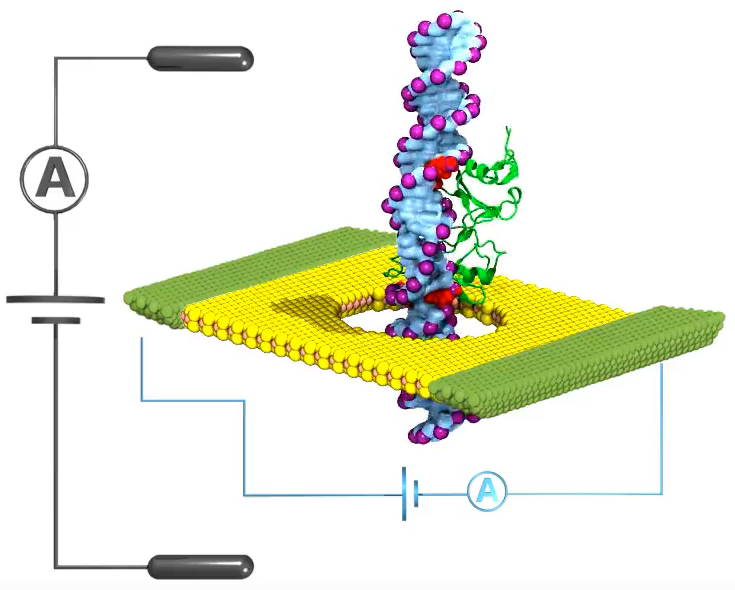Nanopores map small changes in DNA for early cancer detection
April 12, 2017

To detect DNA methylation changes (for cancer early warning), researchers punched a tiny hole (pore) in a flat sheet of graphene (or other 2D material). They then submerged the material in a salt solution and applied an electrical voltage to force the DNA molecule through the pore. A dip in the ionic current (black A) identified a methyl group (green) is passing through, but a dip in the electrical current (blue A) could detect smaller DNA changes. (credit: Beckman Institute Nanoelectronics and Nanomaterials Group)
University of Illinois researchers have designed a high-resolution method to detect, count, and map tiny additions to DNA called methylations*, which can be a early-warning sign of cancer.
The method threads DNA strands through a tiny hole, called a nanopore, in an atomically thin sheet of graphene or other 2D material** with an electrical current running through it.
Many methylations packed close together suggest an early stage of cancer, explained study leader Jean-Pierre Leburton, a professor of electrical and computer engineering at Illinois.
There have been previous attempts to use nanopores to detect methylation (by measuring ionic changes), which have been limited in resolution (how precise the measurement is). The Illinois group instead applied a current directly to the conductive sheet surrounding the pore. Working with Klaus Schulten, a professor of physics at Illinois, Leburton’s group at Illinois’ Beckman Institute for Advanced Science and Technology, they used advanced computer simulations to test applying current to different flat materials, such as graphene and molybdenum disulfide, while methylated DNA was threaded through.
“Our simulations indicate that measuring the current through the membrane instead of just the solution around it is much more precise,” Leburton said. “If you have two methylations close together, even only 10 base pairs away, you continue to see two dips and no overlapping. We also can map where they are on the strand, so we can see how many there are and where they are.”
Leburton’s group is now working with collaborators to improve DNA threading, to cut down on noise in the electrical signal, and to perform experiments to verify their simulations.
The study was published in 2D Materials and Applications, a new open-access journal from Nature Press. Grants from Oxford Nanopore Technology, the Beckman Institute, the National Institutes of Health, and the National Science Foundation supported this work.
* Methylation refers to the addition of a methyl group, which contains one carbon atom bonded to three hydrogen atoms, with the formula CH3.
** Such as graphene and molybdenum disulfide (MoS2).
NewsIllinois | Nanopore detection of DNA methylation